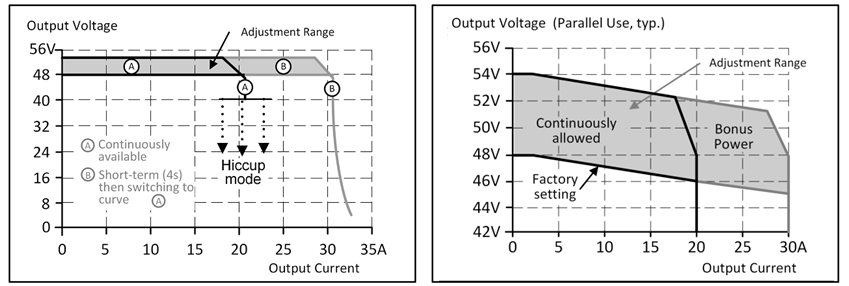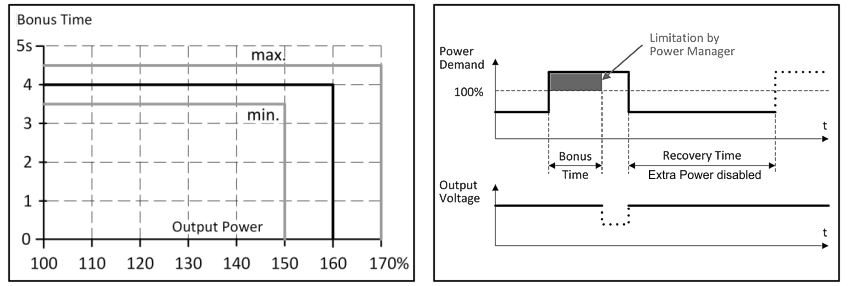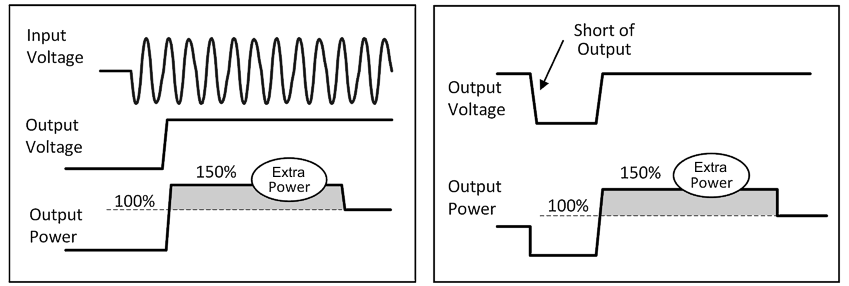Output
Output | |||
|---|---|---|---|
Output voltage | Nom. | DC 48 V |
|
Adjustment range | Min. | 48 - 54 Vdc | Guaranteed value |
Max. | 56 Vdc | This is the maximum output voltage that can occur in the end position of the potentiometer in clockwise direction due to tolerances. It is not a guaranteed value that can be achieved. A typical value is 55 V. | |
Factory settings | typically | 48.0 Vdc | ±0.2%, at full load (cold device), in "Single Use" mode |
typically | 46.0 Vdc | ±0.5%, at full load (cold device), in "Parallel Use" mode | |
typically | 48.0 Vdc | At idle, cold unit, in "Parallel Use" mode | |
Line regulation | Max. | 10 mV | Between 85 and 300 Vac |
Load regulation | Max. | 50 mV | In "Single Use" mode: between 0 and 20 A, static value, see Fig. Output voltage over output current typ. in "Single Use" mode, |
typically | 2000 mV | In "Parallel Use" mode: between 0 and 20 A, static value, see Fig. Output voltage over output current typ. in "Parallel Use" mode, | |
Residual ripple and ripple voltage | Max. | 150 mVPP | Bandwidth 20 Hz to 20 MHz, 50 Ohm |
Output current - | Nom. | 20 A | At 48 V, see Fig. Output voltage over output current typ. in "Single Use" mode; output voltage over output current typ. in "Parallel Use" mode |
Nom. | 17.8 A | At 54 V, see Fig. Output voltage over output current typ. in "Single Use" mode; output voltage over output current typ. in "Parallel Use" mode | |
Output current - | Nom. | 30 A | At 48 V, see Fig. Output voltage over output current typ. in "Single Use" mode; output voltage over output current typ. in "Parallel Use" mode |
Nom. | 26.7 A | At 54 V, see Fig. Output voltage over output current typ. in "Single Use" mode; output voltage over output current typ. in "Parallel Use" mode | |
| typically | 55 A | up to 10 ms, output voltage remains above 40 V, see Fig. Short circuit at output, Hiccup mode, typ.; Dynamic overcurrent capacity, typ. for further peak current measurements see chapter Peak current capability |
Output power - | Nom. | 960 W | At 48 - 54 V |
Output power - | Nom. | 1440 W | At 48 - 54 V |
Extra power time | typically | 4 s | Time until the output voltage drops, see Fig. Bonus time over output power |
Recovery time | typically | 7 s | Overload-free time until the power manager is reset, see Fig. Extra power recovery time |
Overload characteristics |
| Continuous current | Output voltage > 40 Vdc, see Fig. Output voltage over output current |
| Hiccup mode2) | Output voltage < 40 Vdc, see Fig. Output voltage over output current | |
Short circuit current | Min. | 30 A3) | Load impedance 50 mOhm, see Fig. Short-circuit at output, Hiccup mode, typ.; Dynamic overcurrent capacity, typ. |
Max. | 35 A3) | Load impedance 50 mOhm, see Fig. Short-circuit at output, Hiccup mode, typ.; Dynamic overcurrent capacity, typ. | |
Max. | 11.5 A | RMS value of current, load impedance 50 mOhm, see Fig. Output short circuit, Hiccup mode, typ.; Dynamic overcurrent capacity, typ. | |
| typically | 62 A | Up to 10 ms load impedance < 10 mOhm, see Fig. Output short circuit, Hiccup mode, typ.; Dynamic overcurrent capability, typ. |
Output capacity | typically | 3700 μF | Included in the power supply |
1) Extra power
The power supply is designed to support loads with higher short-term power requirements without damage or shutdown.
The short-time duration/bonus time is controlled in hardware by an output power manager.
Extra power is available repeatedly. Detailed information can be found in the chapter on Repeated pulse load.
If the power supply is subjected to extra power for longer than shown in the bonus time diagram (see Fig. Bonus time over output power), the maximum output power is automatically reduced to 960 W.
If the power demand is continuously above 960 W and the voltage drops below approx. 40 V (due to the current control mode in case of overload), the device switches off and periodically makes restart attempts. This behavior is referred to as Hiccup mode (see description below).
If the voltage is above 40 V, the device supplies current continuously.
2) Hiccup mode
In the event of a severe overload, the power supply provides continuous output current for 4 s. The output is then switched off for about 17 seconds before a new switch-on attempt is automatically made. This cycle is repeated as long as the overload persists. If the overload persists, the output current is restored for 2 to 4 seconds (depending on the overload), followed by another recovery time of 17 seconds. After the overload has been rectified, the device will operate normally. See Fig. Short circuit at output, Hiccup mode, typ.
During the pause time, a small residual voltage and a residual current are applied to the output.
3) The discharge current of the output capacitors is not included.



Extra power is available as soon as the power is turned on and after an output short-circuit or output overload.
